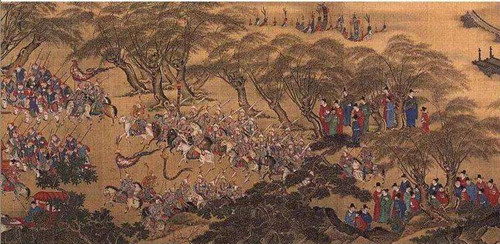Fubing system, one of the ancient Chinese military systems. During the period of Emperor Taizong of Tang Dynasty, it was vigorously developed to make it complete.

The most important feature of this system is the integration of soldiers and farmers. Fubing is usually a farmer who cultivates the land, trains between farms, and joins the army to fight in wartime. Mansion soldiers prepare their own weapons and horses to participate in the battle, and there are Zhechong Mansions responsible for the selection and training of mansion soldiers all over the country. It was built in the Datong period (535-551) by Yu Wentai, a powerful minister of the Western Wei Dynasty. It was gradually completed during the Northern Zhou Dynasty, Sui Dynasty, and early Tang Dynasty. .
Meaning
Fubing originally refers to the soldiers of the military government. The Northern Wei Dynasty was divided into the Eastern and Western Wei after the Six Towns Uprising. In order to compete with the Eastern Wei Dynasty, Yu Wentai of the Western Wei Dynasty organized the soldiers from the six towns who had flowed into the Guanzhong area and the Xianbei tribes who were originally in the Guanzhong into the Sixth Army in the eighth year of Datong (542). The next year, he fought against the Eastern Wei Dynasty and was defeated by Mangshan Mountain in Luoyang, which caused a lot of losses. In order to supplement and expand the team, in the next few years, the township soldiers of the Guanlong Han Hao family were continuously incorporated, and Dangzhou Haowang was selected as the township commander.
Sixteen years ago, Datong had established the military organization system of the Eight Pillars Kingdom (Great General), the Twelve Generals, and the Twenty-Four Kaifu (also known as the Twenty-Four Army). The establishment of the Eight Pillar Kingdom imitated the eight-part system of the Tuoba tribe of Xianbei, in which Yu Wentai was actually the commander-in-chief of the entire army, and Yuan Xin, the Wei clan, was only a false name. The system matches.
Historical Records
Due to unclear records and disagreements, some aspects of the military government organization before the Sui Dynasty are unclear. According to records, Kaifu was “commanded by 24 sub-groups, which is the 24th Army; each regiment has two people named Yitong”. However, Kaifu and Yitong are joint leaders, or should they lead an army separately; whether Yitong set up a mansion independently to lead the army; There are different opinions on these issues in the historian circles on whether the theory of “one hundred prefectures are dissatisfied with one hundred” or “combined into one hundred prefectures” is credible.
It is clear that under Kaifu and Yitong, there are governors, commanders, and governors. In the Sui Dynasty, the military mansion was divided into the inner mansion and the outer mansion (that is, the inner army and the outer army). The generals of the hussars and the generals of the chariots were the leaders, and sometimes the chariot mansions were set up in parallel with the mansions of the hussars. In the third year of Emperor Yangdi’s great cause (607), it was renamed Yingyang Mansion.
Characteristics
The government soldiers have the nature of the central imperial guards. The government soldiers who went to the guards “on the 15th, the gates are guarded with halberds, and the police patrol the day and night; after the 15th, they teach the flags to practice warfare. There is no other tax.” With the strengthening of the centralization system, during the second and third years of Jiande (573-574), Emperor Wudi of the Northern Zhou Dynasty changed the soldiers of the government soldiers to “servants”, meaning guarding the emperor, indicating that the soldiers of the government were the emperor’s pro-army and not affiliated with the state.
At the same time, Han people were widely recruited to join the army and exempted from serving. If one person acts as a military soldier, the whole family is incorporated into the army, not belonging to the state or county. Soldiers and their family members who live in the city set up military workshops, and those who live in the countryside form the township regiments, and the owners of the workshops and regiments are assigned to lead them. This system of military and civilian alienation was not changed until the Sui Dynasty. Emperor Wen of the Sui Dynasty, Yang Jian, issued an edict in the tenth year of Emperor Kaihuang (590): “All soldiers can know that they belong to prefectures and counties, cultivate land and register accounts, and they are the same as the people. They should be in command of the military government.” This is an epoch-making change. The completion of the rural integration, but the organizational system in which the soldiers themselves were under the command of the military government remained unchanged.
Distribution Profile
Due to the infrequent abandonment, the total number of military mansions in the Tang Dynasty also increased and decreased, and there were six hundred and thirty-three mansions at most (one was six hundred and thirty-four mansions). There are as many as 261 prefectures in the Guannei Road, accounting for more than one-third, followed by Hedong, Henan, Hebei, and Longyou. ). This layout embodies the political and military intention of putting more emphasis on control than light, and bringing all the people in the pass to face the Quartet”.